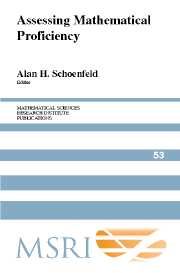Book contents
- Frontmatter
- Contents
- Preface
- Acknowledgments
- Section 1 The Big Picture
- Section 2 Perspectives on Mathematical Proficiency
- Section 3 What Does Assessment Assess? Issues and Examples
- Section 4 The Case of Algebra
- Section 5 What Do Assessments Assess? The Case of Fractions
- Section 6 The Importance of Societal Context
- Epilogue What Do We Need to Know? Items for a Research Agenda
- About the Authors
- Subject Index
- Author Index
- Task Index
Chapter 9 - Learning from Assessment
Published online by Cambridge University Press: 06 July 2010
- Frontmatter
- Contents
- Preface
- Acknowledgments
- Section 1 The Big Picture
- Section 2 Perspectives on Mathematical Proficiency
- Section 3 What Does Assessment Assess? Issues and Examples
- Section 4 The Case of Algebra
- Section 5 What Do Assessments Assess? The Case of Fractions
- Section 6 The Importance of Societal Context
- Epilogue What Do We Need to Know? Items for a Research Agenda
- About the Authors
- Subject Index
- Author Index
- Task Index
Summary
There are many types of assessment and books can and have been written about them. My aim is modest: to point out a few instances of what can be learned by looking at assessments given in the past.
One important use of assessment is to find out where education has been weak. As an example, consider the results in geometry in the 1995 Third International Mathematics and Science Study (TIMSS) assessment of knowledge of advanced students in the last year of high school [Mullis et al. 1997].1 The average score for the 17 countries was 500. The scores ranged from 424 to 548.
As can be seen, the percentage of students taking advanced mathematics in the last year of secondary school could vary widely between countries. In general, the better students take advanced mathematics in their final year of school, so a higher percent of students taking advanced math would tend to lower the average score. Thus the gap between 424 and 462, large as it is, underestimates how much U.S. students are below the students in other countries which did not do very well. This gap is unacceptably large. Neal Lane, then director of the National Science Foundation, pointed this out in his comments in Pursuing Excellence [NCES 1998]. Unfortunately, this gap, which I consider strong evidence of a very poor geometry program in the United States, was not mentioned in Principles and Standards for School Mathematics [NCTM 2000].
To illustrate some of the problems in the knowledge of geometry, consider a classic simple problem from synthetic geometry [TIMSS 1995, problem K18].
All that is needed to solve this problem is to know that the sum of the angles of a triangle is 180 degrees; and write that angle BSC is 140 degrees, so angle SCB is 20 degrees. Angle CSN is 40 degrees, so angles MBS and NCS are each 50 degrees. Thus the base angles are equal, so the triangle is isosceles. This is an easy example of a type of problem which is given in grade 8 in Hong Kong, Japan and Singapore. See, for example, [Chan et al. 2005, problem 38, p. 9.51; Kodaira 1992, problem 3, p. 121; Teh and Looi 2001, problems 1 and 3, p. 323] The first two are eighth grade books, the third is seventh grade. None of these East Asian countries participated in the 1995 TIMSS assessment of advanced students.
Information
- Type
- Chapter
- Information
- Assessing Mathematical Proficiency , pp. 125 - 136Publisher: Cambridge University PressPrint publication year: 2007
